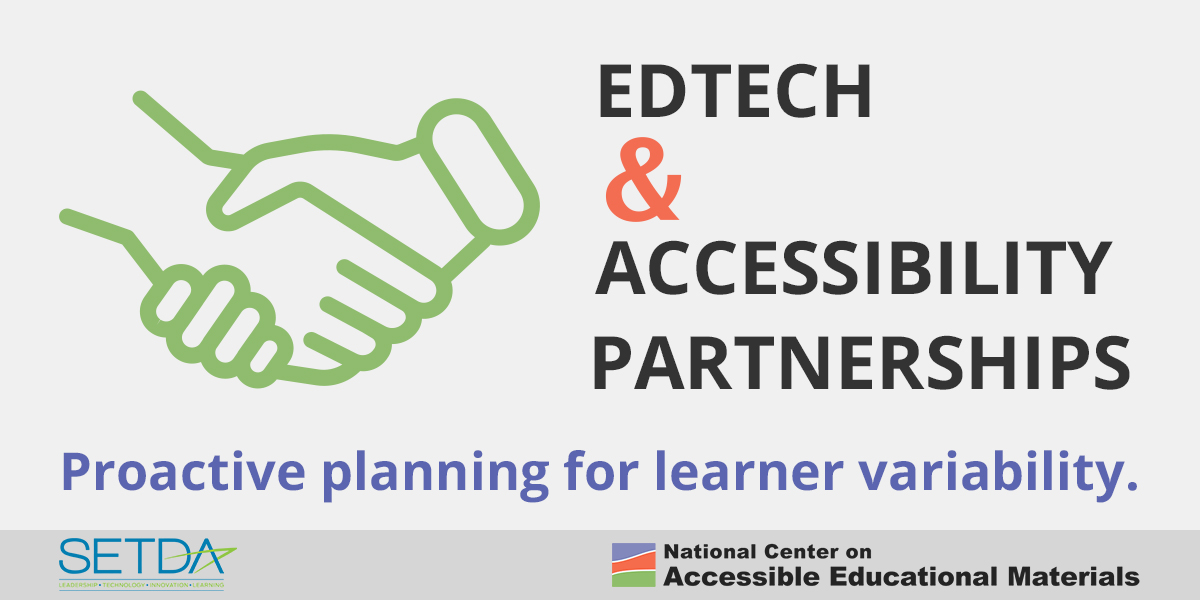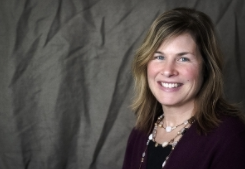We Have An Ed Tech-Accessibility Partnership. So Can You!
Guest Post from Cynthia Curry, Co-Director of the National Center on Accessible Educational Materials for Learning (AEM Center)
 What do you get when you combine a state educational technology director with a state accessibility expert? A partnership that results in students having digital materials and technologies that are usable for learning across the widest range of learner variability, regardless of format or features. According to the Office for Civil Rights, accessibility means that a person with a disability is afforded the opportunity to acquire the same information, engage in the same interactions, and enjoy the same services as a person without a disability in an equally effective and equally integrated manner, with substantially equivalent ease of use. Accessibility professionals not only know technical standards such as WCAG 2.0 AA and Section 508; they know how users with varied abilities interact with technology for learning. This expertise compliments the procurement decision making process in ways that make the difference between equal learning opportunities with technology…and not. To see such a partnership, look no further than how SETDA and the National Center on Accessible Educational Materials for Learning (AEM Center) are working together to ensure that (1) accessibility is embedded in states’ technology procurement policies and practices and (2) developers of emerging and existing technologies are provided accessibility guidance.
What do you get when you combine a state educational technology director with a state accessibility expert? A partnership that results in students having digital materials and technologies that are usable for learning across the widest range of learner variability, regardless of format or features. According to the Office for Civil Rights, accessibility means that a person with a disability is afforded the opportunity to acquire the same information, engage in the same interactions, and enjoy the same services as a person without a disability in an equally effective and equally integrated manner, with substantially equivalent ease of use. Accessibility professionals not only know technical standards such as WCAG 2.0 AA and Section 508; they know how users with varied abilities interact with technology for learning. This expertise compliments the procurement decision making process in ways that make the difference between equal learning opportunities with technology…and not. To see such a partnership, look no further than how SETDA and the National Center on Accessible Educational Materials for Learning (AEM Center) are working together to ensure that (1) accessibility is embedded in states’ technology procurement policies and practices and (2) developers of emerging and existing technologies are provided accessibility guidance.
![accessibility-ocr[3] copy](https://www.setda.org/master/wp-content/uploads/2017/09/accessibility-ocr3-copy.jpg) The AEM Center, a federally funded project at CAST, is charged with building the capacity of a wide range of stakeholders, including state and local education agencies, to increase the availability and use of high-quality accessible educational materials and accessible technologies. We provide tiered technical assistance to all stakeholders, with our most in-depth assistance directed to eight states that make up the AEM Best Practices Cohort, including Alaska, Florida, Indiana, Iowa, Maryland, Minnesota, Ohio, and Texas. With additional support from SETDA, these states are developing accessibility policies and practices that can be scaled to other states. One highlight is the Texas State Board of Education (SBOE), which has made accessibility a core component of its procurement policy by requiring that publishers’ electronic information materials be compliant with WCAG 2.0 AA and Section 508 accessibility standards. Information about Texas’s accessibility policy and practices, as well as those of all states, is included in SETDA’s seminal online database, Digital Instructional Materials Acquisition Policies for States.
The AEM Center, a federally funded project at CAST, is charged with building the capacity of a wide range of stakeholders, including state and local education agencies, to increase the availability and use of high-quality accessible educational materials and accessible technologies. We provide tiered technical assistance to all stakeholders, with our most in-depth assistance directed to eight states that make up the AEM Best Practices Cohort, including Alaska, Florida, Indiana, Iowa, Maryland, Minnesota, Ohio, and Texas. With additional support from SETDA, these states are developing accessibility policies and practices that can be scaled to other states. One highlight is the Texas State Board of Education (SBOE), which has made accessibility a core component of its procurement policy by requiring that publishers’ electronic information materials be compliant with WCAG 2.0 AA and Section 508 accessibility standards. Information about Texas’s accessibility policy and practices, as well as those of all states, is included in SETDA’s seminal online database, Digital Instructional Materials Acquisition Policies for States.
The procurement of accessible digital materials and technologies would not be possible without innovative edtech developers making them available, and the SETDA-AEM Center partnership is making a difference by providing guidance to SETDA’s Private Sector Partners, thereby increasing market availability of accessible products. Events like SETDA’s annual Emerging Technologies Leadership Forum bring AEM Center staff and the private sector together for meaningful dialog about the essentialness of accessibility. Recently, AEM Center Co-Director, Skip Stahl, presented on accessibility for SETDA’s Private Sector Partners.The recording is available: Accessibility Expectations in the EdTech Marketplace: Designing for All Learners.
The SETDA-AEM Center partnership is publicly sealed in Navigating the Digital Shift II: Implementing Digital Instructional Materials for Learning, in which “Accessibility for All Students” is highlighted as a next step for consideration as education leaders continue to advance living and learning in the digital age. The report refers readers to the AEM Center for technical assistance and we welcome your requests.
Several of the AEM Best Practices Cohort states will be represented at the 2017 Leadership Summit & Education Forum via ed tech – accessibility expert teams to engage in meaningful dialog. In the meantime, SETDA and the AEM Center will scheme our next ed tech-accessibility campaign to continue ensuring that learner variability is a fundamental consideration in procurement guidance and policies. To learn about what you can do to advance accessibility of digital materials and technologies for the learners in your state, consider reaching out to your AEM State Contact.
About the Author
 Cynthia Curry is Co-Director of the National Center on Accessible Educational Materials for Learning (AEM Center), a U.S. Department of Education funded project at CAST. She is responsible for ensuring that the Center meets its goal to increase the use of accessible educational materials and accessible technologies by learners with disabilities across PreK, K-12, higher education, and workforce development. She collaborates with state leaders and AEM Center partners to lead the development of AEM and accessible technology provision systems across the country. During her two-decade career in education, beginning as a middle school science teacher, she has worked across K-12 schools, universities, non-profit organizations, and state agencies to improve outcomes for learners with disabilities. Contact information: [email protected] or via Twitter @clcurry
Cynthia Curry is Co-Director of the National Center on Accessible Educational Materials for Learning (AEM Center), a U.S. Department of Education funded project at CAST. She is responsible for ensuring that the Center meets its goal to increase the use of accessible educational materials and accessible technologies by learners with disabilities across PreK, K-12, higher education, and workforce development. She collaborates with state leaders and AEM Center partners to lead the development of AEM and accessible technology provision systems across the country. During her two-decade career in education, beginning as a middle school science teacher, she has worked across K-12 schools, universities, non-profit organizations, and state agencies to improve outcomes for learners with disabilities. Contact information: [email protected] or via Twitter @clcurry
